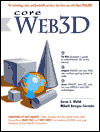
A couple of months ago the ambitious book "Core Web3D" by Aaron Walsh
and MikaŰl Bourges-SÚvenier was published. It's the first widely available book to deal in a substantial way with the 3D component of MPEG-4 and X3D. It also covers
VRML and Java 3D along with a overview of Web3D that puts all these technologies into context.
The book is organized as a series of five Parts:
- Introduction
- Virtual Reality Modeling Language
- Java 3D
- MPEG-4/BIFS
- X3D
This is huge territory to cover well, and the authors partially succeed. The Parts
covering Java 3D and VRML are quite competent but you can find this material in many other
books. The big strength of "Core Web3D" is with the Parts covering
X3D and MPEG-4. This material is hard to find in a coherent organized fashion and the authors
have presented these rapidly evolving technologies clearly.
Actually the Part on X3D is a terrific overview of the evolution and history of X3D, however
it's not particularly technical. Of course the reason it's not technical is because it would be
premature to get into the entire spec, since it isn't finished and as of the time of publication
was undergoing significant changes. The chapter "Weaving X3D into Web Pages" provides a
terrific overview of what the authors call X3DML, the XML encoding of VRML, (also commonly known
as X3D). It's a good explanation of XML and how it's being used to encode the VRML scene graph and how
that encoding will be used to integrate 3D with the Web.
The best part of the book is the Part covering MPEG-4. After reading and skimming through it
I finally got a much clearer understanding of how MPEG-4 BIFS (Binary Format for Scenes) relates
to the MPEG standard. It provides a great explanation of how the BIFS portion of MPEG-4 encodes
the VRML scene graph and add interactivity to the MPEG mix.
The MPEG Part of the book consists of four Chapters:
- MPEG-4 Overview
- MPEG-4 Binary Format for Scenes (BIFS)
- Animating Scenes with BIFS-ANIM
- Customizing VRML for BIFS
- X3D
The book, all 1000 plus pages is worth it just for the coverage of MPEG-4. Oh by the way my
bookstore is back up and you can conveniently buy it (from Barnes and Noble) In
addition the book makes a great introduction to VRML, and Java3D providing good context
for the tumultuous and still rapidly changing world of Web3D.


